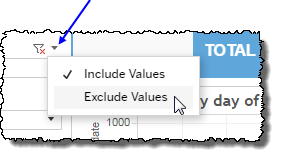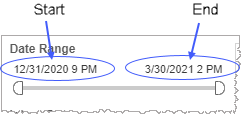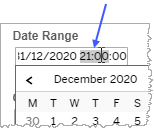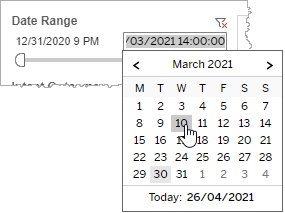Metrics Trends
The Metrics Trends report presents metrics data as it changes over time.
Note: The Metrics Trends graph does not populate with data until you select a metric in the Metric Name filter.
In addition to the use of report filters, Nuance Insights allows you to manipulate displayed data through several other means in order to better visualize information. Select from the following to learn more:
Visualization
You can view the data for this section either as a stacked trending graph or in a text-only table. Both formats contrast metric usage within a channel, comparing the number of conversations having any value for a given metric to the number having any value of all other metrics. This is a ratio and is expressed as a percent weighting for each metric.
Note: To see the data from the graphical visualization displayed in an alternative, textual way, click Show Table. To toggle back to the graphical view, click Show Graph.
The graph visually stacks each metric's percent value in a vertical column adding up to 100%. In the example, below, there is one conversation with the exitreason metric having a value of COMPLETE in the IVR/Voice VA channel for the January 13th, 2021 data point out of a total of two conversations on that date in the same channel that had any metric having a value of COMPLETE. This one conversation represents 50% of all conversations with a value of COMPLETE for any metrics keeping channel and data point constant.
Note: For each data point, the percent values of all metrics add up to 100%.

The table visualizes the relative weighting of individual metrics with non-null values in a channel in the Conversation Percent column.
Filters
Increase the specificity of your view's reporting by applying filters to the data.
Clicking Include values displays only those data possessing the selected values. All other data are hidden from the visualization.
By contrast, clicking Exclude values displays only those data that do not possess the selected values.

Date Range
The Date Range filter is a slider with two moveable sides. By narrowing the date range, you display only data falling within the range.

In addition to the slider, the filter allows you to specify start and end points to the range by time of day as well as by date by clicking the Start and End regions, clicking a second time on the time of day, and then manually entering a new time of day.


To select a date with the date picker, click the Start region to pick a date from the date picker widget. Do the same with the End region.

Date Granularity
The Date Granularity filter allows you to adjust the reported data granularity described by the trend lines. Drag the slider horizontally to adjust the granularity of reported data. Alternatively, you can use the left  and right
and right  arrow buttons to move the slider incrementally.
arrow buttons to move the slider incrementally.

Note: If you choose to draw from hourly instead of daily summarization data, the Date Granularity filter will no longer be visible.
Metric Name
Select one of the metrics from the list to view this metric's data in the report visualization.
Channel
By choosing one or more channels from the list, you refine your displayed data-set by including data from only those channels matching the selection.
- Select all available values by selecting All.
- Select only one value by first clearing the All checkbox, and then selecting the value whose data you would like to see visualized.
-
Select several values by doing one of the following:
- Clear the All checkbox, and then select the values whose data you would like to see visualized.
- Select the All checkbox and then clear values whose data you would NOT like to see visualized.
Metric Value highlight tool
Use this tool to highlight data having one or several specified metric values.
- In the Metric Value highlight tool, mouse over the word Metric Value to see the highlighter icon to the right.
-
Click the highlighter icon to toggle the highlighter on (
 ) to highlight metric values, or off (
) to highlight metric values, or off (  ) to remove highlighting.Notes:
) to remove highlighting.Notes:- To make multiple selections, hold down the ctrl key while individually clicking desired metric values.
- If you made a highlighter selection of metric values and then toggled the highlighter function off, the last selection is preserved when you once again toggle the highlighter back on.
Custom filters
This report accommodates customizable filters.
Customizable filters narrow the scope of the reported dataset by including or excluding data with identifiable attributes. These attributes may be about the conversation itself or about an event that may have happened during the conversation.
For more information about how to add customized filters to your view, contact your Nuance Professional Services representative.
Note: If you would like to modify this or any report, Nuance Communications, Inc. recommends you contact Nuance Professional Services.
